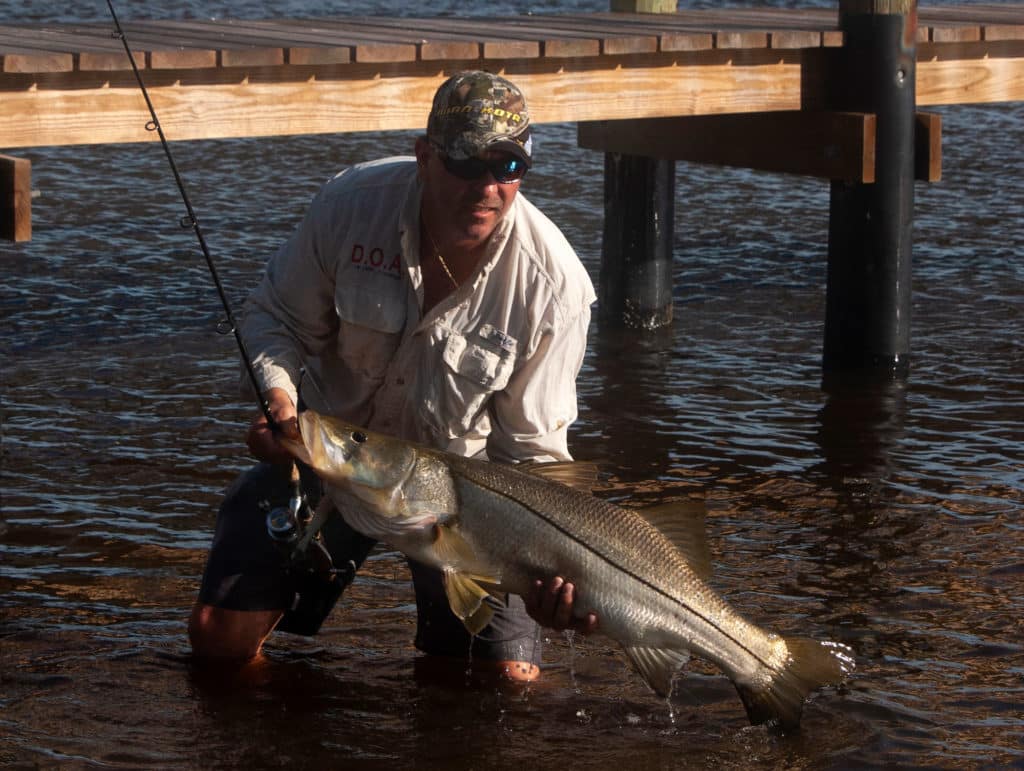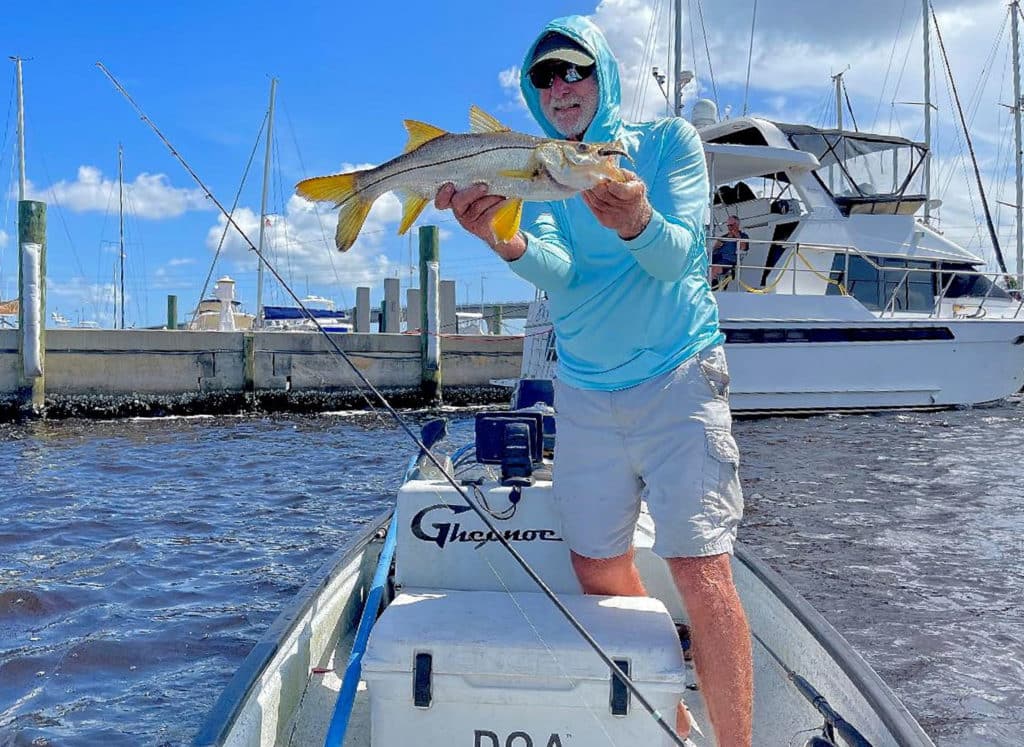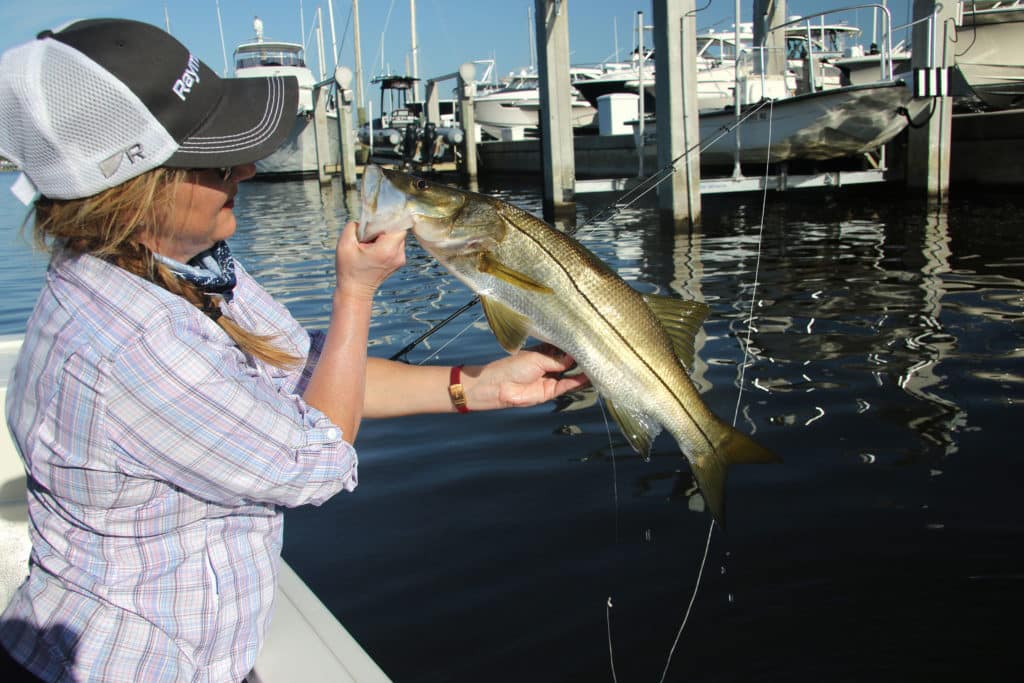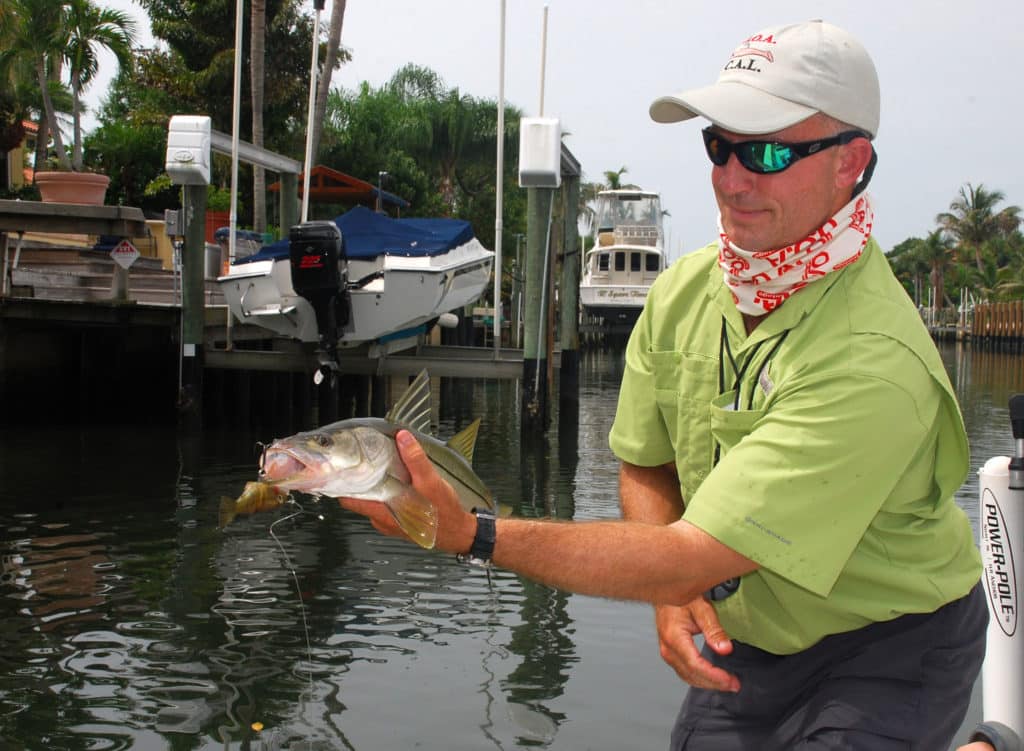
With the February opening of snook season along Florida’s southeast coast, anglers can begin to hunt linesiders around boat docks and bridges. Cooler temperatures have concentrated the fish in warmer, inshore zones. And while Gulf Coast snook hover around mangrove islands, South Florida snook seek harbor and ambush spots near manmade structure.
Dock Detective
As with natural habitat, some boat docks prove more productive than others. Capt. Mark Nichols, founder of D.O.A. Lures, likes docks in shallow water that offer easy access to deep zones. The deeper water is warmer, and its proximity to shallow areas allows snook to transit to a dock when they want to pick off an unsuspecting baitfish or shrimp. “If you’ve got a dock with a big boat that sits there a lot, they like that, too,” says Nichols, who lives and fishes in Stuart, Florida.
Nichols says docks can produce day or night as long as the tide is moving. He prefers the last half of an outgoing tide and full light or full dark. “I don’t start fishing until an hour after dark,” he says. “If I’m fishing during the day, I want the sun to be up for a while so the fish go under the dock for shade.”
The best docks for night fishing feature lights that create shadow lines on the water. Snook stay on the dark side of the line and wait for the tide to bring shrimp and baitfish to them.

Shadows and Skipping
To fish such a dock properly, Nichols casts his lure — usually one of his company’s plastic shrimp — into the light and lets it drift with the tide into the shadow. “If the dock has no lights or you’re fishing during the day, then you work close to the structure. Skip your lure under the dock. It’s like skipping a rock. You release the rock low to the water and you want to release the lure low to the water.”
Nichols skips his lure as far under a dock as possible. Even if he has plenty of room to cast a shrimp under a dock, he prefers to skip it because that imitates a shrimp’s natural action. It gets a snook’s attention.
When the lure stops skipping, Nichols lets the bait fall. Too many anglers immediately move the lure, which takes it out of the strike zone. “A lot of people make great casts, then reel in the lure before it has a chance to settle,” he explains. “When you let the bait fall, the shrimp glides down like a real shrimp. I try to get the bait to the fish’s comfort zone, rather than try to make the fish chase the bait.”
If a snook doesn’t hit on the fall, Nichols retrieves the shrimp with a series of light rod twitches. If he’s using one of his company’s baitfish imitations such as the TerrorEyz or Baitbuster, which usually produce fewer strikes but bigger snook, he retrieves the lure with slow sweeps of the rod after the bait sinks to the bottom.
After skipping a shrimp under a dock, Nichols leaves the spinning-reel bail open until line stops coming off the reel. That way the plastic shrimp sinks naturally to the bottom.

Slow Motion
When fishing a grass flat with a D.O.A. Shrimp, slow the retrieve. Nichols holds the rod tip high and twitches the shrimp out of the seagrass. He notes that you don’t even have to turn the reel handle because the shrimp drifts a few feet before settling back into the grass.
Live shrimp with a split shot or two crimped above the hook also can be cast under docks, Nichols says. Live and plastic shrimp, as well as small swimming plugs, can be slow-trolled along the edges of docks to reveal the structures that are harboring snook.
The fun begins when a snook grabs the bait. The barnacle-encrusted pilings of docks can make short work of most fishing lines. Nichols uses 15-pound PowerPro braided line that he attaches with a triple surgeon’s loop to 2 feet of 30- to 50-pound fluorocarbon leader. “The braided line definitely allows me to pull them out from around stuff,” he says.
Anglers also find success this time of year by working jigs and plugs along the shadow lines of lit bridges over the Intracoastal Waterway. Trolling lures such as a Bomber Long A’s or Rat-L-Traps along and through bridges also works.
Personal Experience
Working lures properly really makes a difference. When I fished for seatrout in the Indian River with Nichols, he consistently caught fish while I struggled to get a bite. At one point, I kiddingly complained that he must be using a special version of his shrimp and had given me one of his company’s rejects. So he gave me his spinning outfit and took mine. Then he promptly caught a trout on the shrimp I’d been using, while I remained fishless.
Whichever way you pursue linesiders this time of year, stick with structure to find the best chance of hooking a snook.
Read Next: More Snook Fishing Tips

Snook by the Book
Snook regulations in Florida can be confusing, with different dates and slot sizes for the Atlantic and Gulf coasts.
Seasons: In Atlantic waters, the season is open from Feb. 1 to May 31 and from Sept. 1 to Dec. 14. In state waters of the Gulf of Mexico and the Florida Keys (Monroe County) and in Everglades National Park, snook season is open from March 1 to April 30 and from Sept. 1 to Nov. 30. The season is currently closed through Aug. 31 in the waters from Sarasota Bay through Gordon Pass in Collier County.
Limits: The statewide daily bag limit is one snook per angler. The slot limit in Atlantic waters is not less than 28 inches or more than 32 inches total length from the most forward point of the lower jaw to the tip of the tail with the tail pinched. The Gulf slot limit is 28 to 33 inches.
Tackle: It is unlawful to take snook by any means other than hook and line; also with live or dead natural bait in conjunction with a treble hook.
Licenses: Any angler needing a saltwater fishing license must also have a $10 snook stamp to possess snook. No saltwater fishing license is needed for anglers under 16, Florida residents 65 and older, Florida residents fishing in saltwater from land or from a structure fixed to the land, and anglers fishing from a licensed boat or pier.








